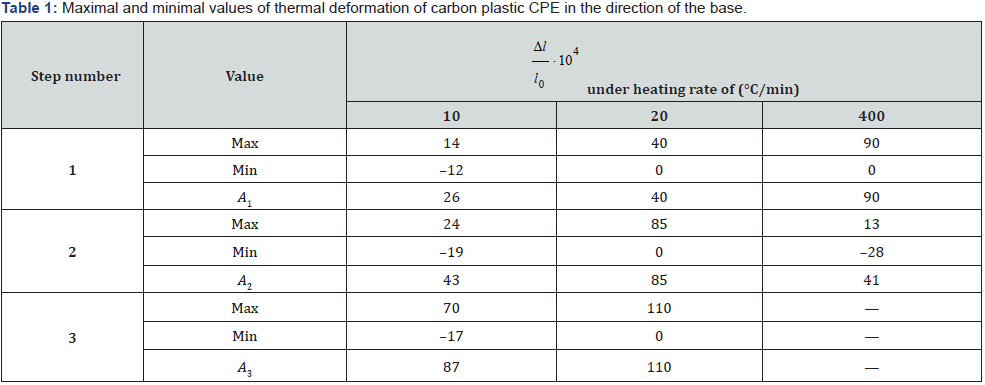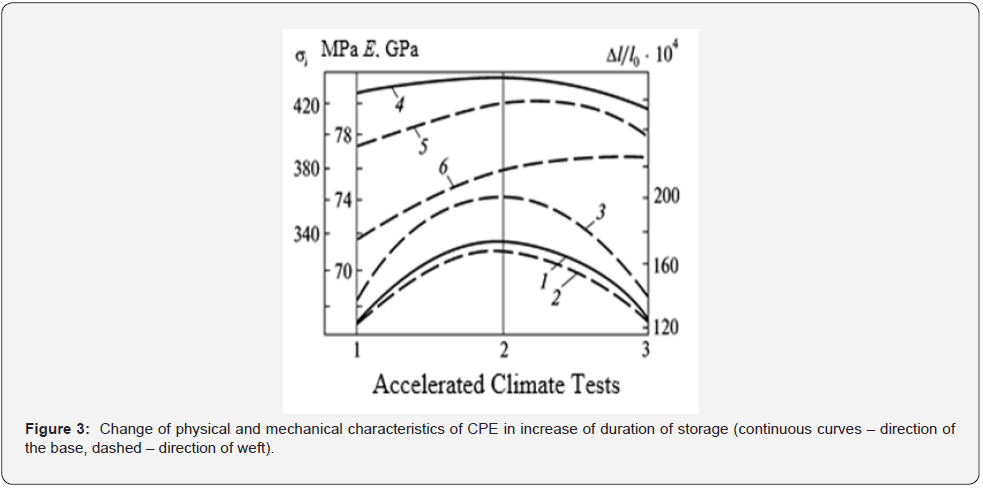Physical and Mechanical Properties of Epoxy Carbon Plastic During Ageing in A Moderate Climate
Lyudmila I Gracheva*
G. S. Pisarenko Institute for Problems of Strength, National Academy of Sciences of Ukraine, Kiev, Ukraine
Submission: November 11, 2021; Published: May 24, 2022
*Corresponding author: Lyudmila I. Gracheva, G. S. Pisarenko Institute for Problems of Strength, National Academy of Sciences of Ukraine, Kiev, Ukraine
How to cite this article: Lyudmila I G. Physical and Mechanical Properties of Epoxy Carbon Plastic During Ageing in A Moderate Climate. Eng Technol Open Acc. 2022; 4(2): 555634. DOI: 10.19080/ETOAJ.2022.04.555634
Abstract
This experimental study provides an account of how storage duration (5 years, 10 years) affects both physical and mechanical properties of carbon plastic on epoxy base used in high-temperature applications. Storage duration was varied under changing temperature regimes. Accelerated climate testing showed that strengthening of the composite occurs, accompanied by a drastic difference in temperature deformation of composite samples as compared to an initial state. Anisotropy of composite material is considered.
Keywords:Carbon Plastic; Epoxy resin; Temperature Deformation; Fairing; Carbon Fibers; Thermal Deformation
Opinion
Use of composite materials reinforced with carbon fibers in missile technologies (inter-stage compartments, shells, fairings, plumage, wings, etc.) is defined by a possibility to reduce mass in increasing strength of the structure of a flying vehicle (FV). A head fairing (HF) is designed for protection from aerodynamic and thermal loads in going through dense atmospheric layers, in transporting to a launch pad and keeping FV on it as well. HF is a rotational body consisting of a front double conical part and a cylindrical part. HF consists of two identical leafs connected by mechanical locks along a longitudinal joint. As carrying fairing skins (FV) structures from a unidirectional carbon plastic based on epoxy binder are used. A distinctive peculiarity of composites based on epoxy resin is a possibility to vary physical and mechanical properties widely (filling, different physical actions). Realization of these opportunities in different carrying structures brings to decrease of mass, expansion of temperature interval of maintenance, improving characteristics related to reliability and durability [1,2]. This paper demonstrates results of experimental study of physical and chemical properties of epoxy carbon plastics vs. temperature while varying a storage term under atmospheric exposure. Matrix in a considered carbon plastic is epoxy resin – a thermo-reactive polymer with cross-sectional link, polymer chains in it are connected to each other in the solidification process and form a three-dimensional grid [3].
The filler in a carbon plastic are stripes made of carbon fibers. From the known, carbon fibers have the largest values of specific strength and rigidity. Peculiarity of operation of polymer CM at high temperatures is that in heating their physical and chemical transformations occur, with thermo-reactive matrix transforming into a sponge-like composition consisting of coke strengthened by fibers. This new material is essentially different from the original one, and transformation from one state to the other goes on continuously [4,5]. In heating up above the Debye temperature, when specific thermal capacity becomes independent on temperature, in a uniaxial stressed state for long prismatic samples there holds a thermodynamic relation [6]:

where α coefficient of linear thermal expansion (compression),  seccspecific heat capacitances at constant stress and deformation respectively; E-elasticity module. In heating, parameters
seccspecific heat capacitances at constant stress and deformation respectively; E-elasticity module. In heating, parameters  sacand E are changing with rates proportional to the rates of chemical reactions, while the connection between them remains constant. We implemented an experimental study of both thermal deformation and strength of a typical carbon plastic on an epoxy base (CPE), depending on duration of action of natural factors in storage under exposure to external conditions. Testing is made for three steps of accelerated climate testing (ACT), imitating
the following durations of the component storage:
sacand E are changing with rates proportional to the rates of chemical reactions, while the connection between them remains constant. We implemented an experimental study of both thermal deformation and strength of a typical carbon plastic on an epoxy base (CPE), depending on duration of action of natural factors in storage under exposure to external conditions. Testing is made for three steps of accelerated climate testing (ACT), imitating
the following durations of the component storage:
• 1st step – initial state
• 2nd step – 5 years of storage
• 3rd step – 10 years of storage under given climate conditions.
Samples of dimensions 1x10x60 mm were cut from natural covers of the head fairings.
Heating rate of samples up to the temperature of 2100C in an oxidizing gaseous medium were: 10, 20, 4000C/min for a 10 min exposure. Cooling of samples is unconstrained, along with a water-cooled, closed chamber [7,8]. Results of experimental study of thermal deformation of carbon plastic reinforced with carbon stripe along the base [00] are presented on (Figure 1), along the weft – on (Figure 2).


On all figures, in the dependencies of the relative thermal
deformation on temperature some designations are accepted:
numbers next to the curves – numbers of steps of climate testing
and the heating rates of the samples,  and min
and min  .Increase of the heating rate brings to the increase of temperature expansion in heating, and to decrease of its shrinkage in cooling.
.Increase of the heating rate brings to the increase of temperature expansion in heating, and to decrease of its shrinkage in cooling.
Temperature deformation of samples CPE after 5 years of
storage (2nd step) is drastically different from that in the initial
state. At a final in our case temperature 210 shown on (Figure 1),
demonstrates the difference of adhesion interaction of the epoxy
binder with the filler before and after ageing. Due to difference
in sign, coefficients of linear thermal expansion (for the binder
– positive, for the carbon filler – negative [9]), in increasing the
temperature there are two competitive processes – expansion and
shrinkage. Destruction of adhesion bonds worsens interaction of
the filler with the binder, and for the aged samples, cut along the
direction of reinforcement, causes shrinkage.
shown on (Figure 1),
demonstrates the difference of adhesion interaction of the epoxy
binder with the filler before and after ageing. Due to difference
in sign, coefficients of linear thermal expansion (for the binder
– positive, for the carbon filler – negative [9]), in increasing the
temperature there are two competitive processes – expansion and
shrinkage. Destruction of adhesion bonds worsens interaction of
the filler with the binder, and for the aged samples, cut along the
direction of reinforcement, causes shrinkage.

Maximal values of thermal deformation CPE along the weft
[900] for a heating rate  is large compared to those
for the base of the order of magnitude, for
is large compared to those
for the base of the order of magnitude, for  – five
times as large, for
– five
times as large, for  – practically do not change.
Extreme values of thermal deformation of carbon plastic CPE
in the direction of the weft are shown in (Table 2). Changes of
both physical and mechanical properties of CPE vs. duration of
its storage are shown on (Figure 3). Curves 1-3 show change of
amplitude values of a thermal deformation in the range 20-210-
200C. For studied heating rates, there is an increase of values of an
amplitude of thermal deformation after five years of storage (2nd
step). Curves 4-6 show the change in mechanical characteristics of
CPE – destructive stress
– practically do not change.
Extreme values of thermal deformation of carbon plastic CPE
in the direction of the weft are shown in (Table 2). Changes of
both physical and mechanical properties of CPE vs. duration of
its storage are shown on (Figure 3). Curves 1-3 show change of
amplitude values of a thermal deformation in the range 20-210-
200C. For studied heating rates, there is an increase of values of an
amplitude of thermal deformation after five years of storage (2nd
step). Curves 4-6 show the change in mechanical characteristics of
CPE – destructive stress  and elasticity module E in stretching
under normal temperatures. From graphs the smallest value of
and elasticity module E in stretching
under normal temperatures. From graphs the smallest value of
 and E in stretching are characteristic for the 1st step of the
component storage (1 year), then follows strengthening of UPE (5
years). Data for the 3rd step of storage (10 years) are compatible,
within the error spread, with those for the second step CPE [10].
and E in stretching are characteristic for the 1st step of the
component storage (1 year), then follows strengthening of UPE (5
years). Data for the 3rd step of storage (10 years) are compatible,
within the error spread, with those for the second step CPE [10].
A performed multi-factor study of physical and mechanical properties of carbon plastic on epoxy base, used as a carrying surface of head fairings depending on storage duration in changing temperature regimes, considering anisotropy of the composite, showed:
i. amplitude values of thermal deformation in the temperature range 20 – 210 -200C are increasing on five years and are decreasing to an initial state after 10 years of FV storage.
ii. decrease in heating rate of a carbon plastic (from 400 down to 100C/min) brings to a multiple increase of anisotropy of its thermal deformation [72].
iii. change of elastic properties of epoxy carbon plastic in ageing is due to, mainly, to joint processes of solidification (stitching) and destruction of the binder.
iv. sorption of water in the epoxy binder increases processes of solidification, due to this shrinkage is minimal for carbon plastic after 10-year storage as destruction processes slow down.
v. we established that after 5 and 10 years of storage (2nd
and 3rd steps of Accelerated Climate Testing) occurs strengthening
of the composite: destructive stress  and elasticity module E
in stretching under normal temperature increase both in the
direction of the base and in the direction of weft.
and elasticity module E
in stretching under normal temperature increase both in the
direction of the base and in the direction of weft.
with an increase in temperature up to 1600C, the strength limit of the carbon plastic in stretching, in the direction of samples cuts of 0 and 90° is decreasing about 1.7x – 2.0x, while the elasticity module is practically unchanged.


References
- Aniskevich К К (1989) Evaluation of the function of temperature-time reduction EDT-1¬0 based on the results of dilatometric tests МКМ pp: 737-740.
- Kochetkov V A (1987) Effective characteristics of elastic and thermophysical properties of a unidirectional hybrid composite. Message 2 МКМ pp: 250-255.
- Voloskov T A, Morozov V N, Lipskaja V A and oth (1987) Epoxy binders and assessment levels of their physical and mechanical properties MKM pp: 585-591.
- Н Grassi N (1988) Polymer degradation chemistry–M: Publishing house of foreign lit-ry, pp. 252.
- Polezgaev Ju V, Jurevich F B (1978) Thermal protection- M: Energiya. pp. 392.
- Рheivud R (1983) Thermodynamics of equilibrium processes- M: Mir. pp. 492.
- Gracheva L I (2006) Thermal deformation and performance of thermal protection materials– K: Nauk Dumka, pp. 294.
- Lyudmila I Gracheva (2019) Predicting performance of thermal shield of a spacecraft in high-temperature gas flow. Journal of Mechanical Engineering Research 2(1): 25-35.
- Aleksandrov A Ja, Ahmetzjanov M H (1973) Polarization-optical methods of deformable body mechanics. Nauka, Moscow, Russia, pp. 576.
- Gracheva L I (2005) Thermal stresses in composite materials at the manufacturing state Thermal stresses’05: Proc. 5-th Int. Cong. on Thermal Stresses and Related Topics 26-29 May. – Vienna: University of Technology, Austria 1: 763-766.






























